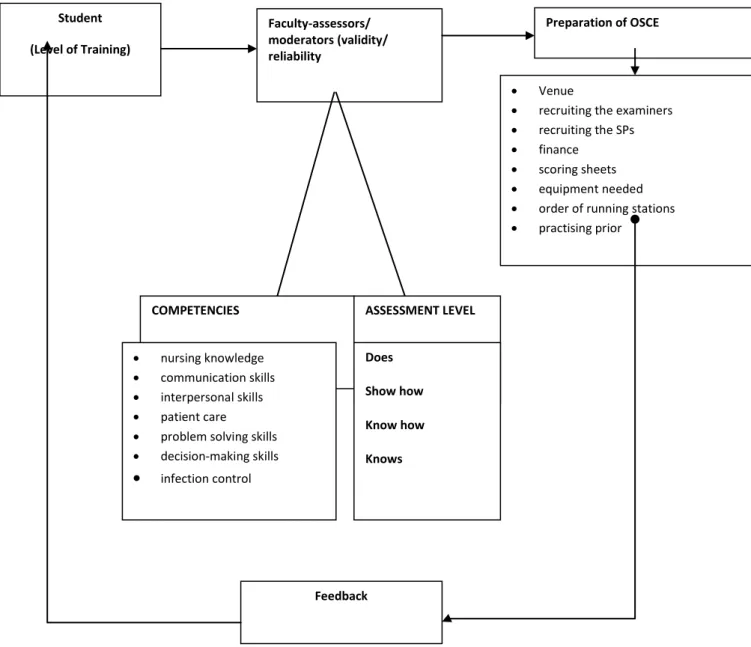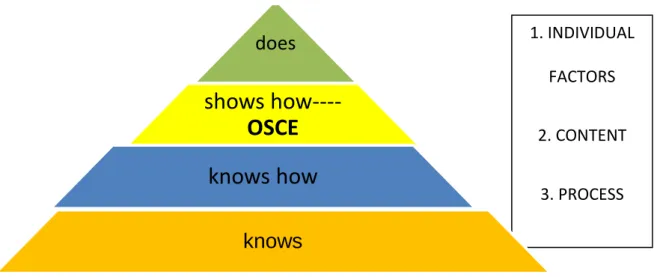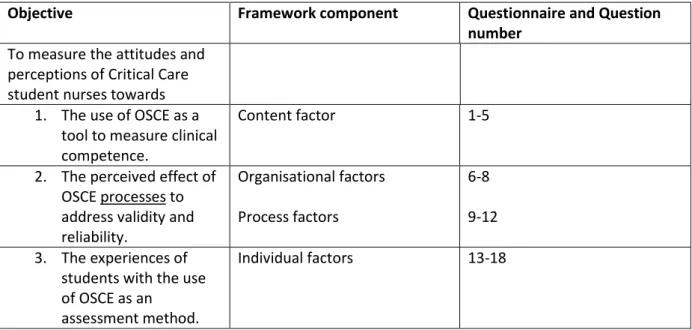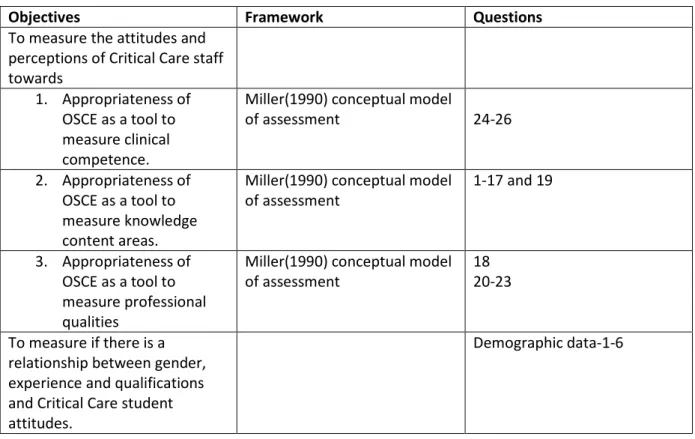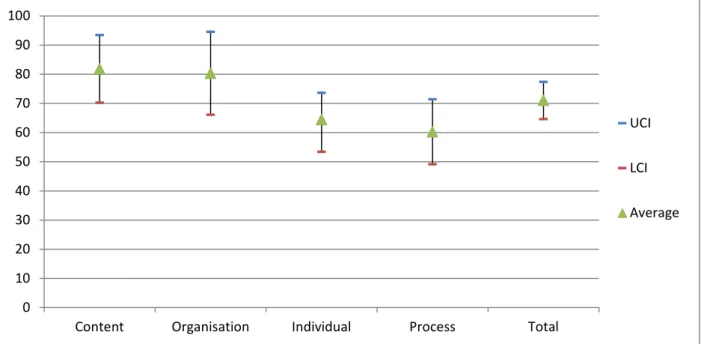Methods: A quantitative approach and descriptive survey was conducted among critical care nursing students and qualified critical care nurses who had participated in the OSCE. The intensive care units of two provincial (state) hospitals and (provincial) nursing schools where intensive care nurses were trained were used.
11
Introduction
This study aims to assess the use of the OSCE in the South African context for critical care nurses, including student nurses who were practicing critical care nursing at the time of the study. The critical care nursing program offered by this college is a one-year course culminating in a diploma in critical care nursing.
Background
Botwinski 2010), where the student will be confronted with a critical or ordinary nursing practice (Munoz, O'Byrne et al. 2005). A few researchers argued that although OSCE is expensive to prepare, the benefits exceed the effort (Wallace, Rao et al. 2002).
Rationale for Study
This research will therefore identify the challenges faced by students when the OSCE assessment method is used to measure their clinical skills and also look at the objectivity and validity of using the OSCE as a form of assessment. It will also outline how the use of the OSCE as a form of assessment can impact on student learning, as well as examine the extent to which the use of the OSCE as an assessment tool helps to ensure that the candidate has the necessary skills to practice safely in the clinical situation.
20
- Problem Statement
- Purpose
- Objectives
- Hypothesis
- Definition of terms
The aim of the study was to measure the perceptions and attitudes of intensive care students and qualified intensive care nurses about the use and appropriateness of the OSCE as a tool for measuring the clinical competence of intensive care students. Operational definition: This is the self-reported understanding of student nurses and qualified intensive care nurses regarding the use of the OSCE as an assessment tool to measure clinical competence.
24
Introduction
OSCE in Critical Care Education
25 community-based patient care (Distler 2007); and also due to the reduction of staff available for mentoring and supervising students (Bremner, Aduddell et al. 2006). This presents the greatest challenge for nurse educators as they must facilitate the integration of theory and practice (Brosnan, Evans et al. 2006) by creating a clear bridge to close the theory-practice gap (McCready 2007).
OSCES and assessment
This backwash occurs when students' learning depends to a large extent on what they perceive on which they will be assessed (Tiwari, Lam et al. 2005). According to (Biggs 2003), nursing knowledge can only be acquired through an in-depth approach to learning that has a solid theoretical foundation (Tiwari, Lam et al. 2005).
Competence assessment using OSCE
Benner (1982) defines competence as the ability to execute a task with desirable results in a variety of real-world circumstances (Dunn et al., 2000). The behavioral or performance-based approach emphasizes the individual's ability to perform visible tasks (McMullan, Endacott et al. 2003).
Assessing and measuring clinical competence in OSCEs
2011) also states that it is difficult to determine the level of competence, as well as to determine the level at which the student was considered disabled, but states that it is easier to identify disability than competence (Levett-Jones, Gersbach et al. 2011 ). 38 students are competent to practice and who decides which areas of practice are important than others (Levett-Jones, Gersbach et al. 2011).
Advantages of OSCE
In the cross-sectional study done by Awaisu et al. 2010), about 80% of students in this study believed that the OSCE was helpful in revealing their areas of weakness and strength in their clinical skills. The OSCE can also assist in assessing the manner of the subject's surrender (Awaisu, Abd Rahman et al. 2010).
Tools and methods used in OSCEs
- Use of standardised patients or simulated patients
- Developing case scenarios in OSCEs
- Tools used in OSCE assessment
- Pass mark
- Level of expertise
- Feedback
- Stress and anxiety due to participating in OSCEs
- Controversy regarding the validity and reliability of the OSCE method
- Acceptability of OSCE as a method of assessment
- Conclusion
The marking criteria should relate to the skills assessed to ensure the validity of the OSCE station (Jones, Pegram et al. 2010). Another issue was the reliability of the OSCE, which also seems to depend on the consistency of the assessor's judgment (Pell, Fuller et al. 2010). The study by Brosman et al. 2006) reveals that mature students achieve more marks in the OSCE than younger ones (Brosnan, Evans et al. 2006).
Feedback is crucial for guiding students toward expected performance goals (Perera, Mohamadou et al. 2010). Most of the literature on student perceptions of this assessment method indicates that it is the most intimidating and anxiety-provoking assessment method (Zartman, McWhorter et al. 2002).
65
Introduction
Miller’s Framework
- Levels of Assessment
At the bottom of the pyramid is Knows-level factual recall, which can be tested using multiple-choice questions, essays, and oral tests. The Know How level context-based assessment, which demonstrates the ability to use knowledge from a particular perspective. The Show How level assessment of competence at this level reveals the person's abilities to act appropriately in a particular situation and this can be tested using simulations or OSCE.
It is important to note that the OSCE cannot reveal how an individual will actually act in real practice. This level refers to actual performance in real practice - this can be identified through observation in a real situation.
System Framework
- Individual factors
- Content
Individual factors include factors important to students and faculty that may affect the validity and reliability of the OSCE. Students: The level of the student to be assessed must be taken into account, since. This also includes the learning objectives of the students, because the OSCE session must meet the learning objectives (Gupta, Dewan et al. 2010).
One way to test candidates' clinical competencies is to design the clinical tasks of the OSCE to map the learning objectives of the course and candidates' learning levels (Boursicot and Roberts 2005). The age and gender of the SPs must match the case scenario that the individual SP must present.
70
- Setting
- Design
- Population and Sampling
- Student Population and Sampling
- Staff Population and Sampling
- Tools
- Questionnaire for Students
- Questionnaire for Staff
- Validity and Reliability of Tools
- Reliability
- Validity
- Data collection process
- Data analysis
- Data analysis Student Questionnaire
- Ethics
SECTION A- (Questions 1-7c) focused on the demographics of students registered as critical care nurses in 2010-2011. SECTION B- used a five-point Likert scale to measure the perception and attitude of intensive care students towards the use of OSCE as an assessment method. SECTION A- (Questions 1-7b) focused on the demographics of intensive care lecturers and qualified intensive care nurses who were still in the field.
Honesty: The researcher was completely honest with the students, Critical Care nurses and lecturers in this study. The students were informed that their participation in the study would not affect their grades in the Critical Care course.
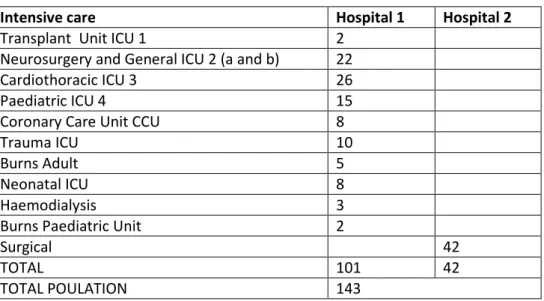
82
Introduction
Second, staff perceptions of the validity of the OSCE to assess critical care competencies were measured using a total of 23 skills.
Perceptions of the students experience of the use of OSCE as a clinical tool
- Demographics
- Perceptions of Content Factors
- Perceptions of organisational/environmental factors
- Perceptions of processes of administrating an OSCE
- Perceptions of the Individual Factors
- Overall perceptions’ score
Perceptions of content were measured using six items, namely whether the content of the stations was relevant to the level of training, whether the tasks reflected skills learned, or the wide range of knowledge covered by the OSCE,' had a good balance of subjects and whether, in general, the OSCE was worthwhile. The highest level of agreement was for "Relevance to training" with 20 of the 22 students agreeing (90.9%), with the lowest level of agreement being for "range of knowledge". It was also the only item where the level of agreement was below 75%. Table 5 shows the level of agreement of students (% agreed) with each of the items.α.
There was a high level of agreement, with most students believing that they would incorporate what they learned in OSCE into clinical practice and also believing that they had learned a lot from OSCE, while fewer students felt that inter-patient and in-rater variability affects the OSCE score and few students believe that OSCE exams cause the same anxiety as other exams, 9 (40.9%). Comparing the standard scores for all factors, the highest level of agreement was with content and the lowest level of agreement was with process.

Perceptions of the staff regarding the use of OSCE as a clinical tool
- Demographics
- Perceptions of usefulness of OSCE
- Perceptions of relevance of using OSCE to evaluate specific Critical Care
- Types of skills, levels of assessment and types of patients that can be used for
- Overall level of Agreements on Relevance of OSCE
- Overall level of Agreements on Simulated or Real Patients
Cardiopulmonary resuscitation: Some of the participants felt that cardiopulmonary resuscitation was a valid skill assessed by an OSCE (Table 9). 93 passing this skill in an OSCE exam would mean that a person would be able to. Performing a neurological observation: Some of the participants felt that performing a neurological observation is a valid skill that can be assessed using an OSCE (Table 9).
Performing a cardioversion: Some of the participants felt that performing a cardioversion was a valid skill that could be assessed using an OSCE (Table 9). Measuring abdominal distension: Some of the participants felt that measuring abdominal distension was a valid skill that could be assessed using an OSCE (Table 9).
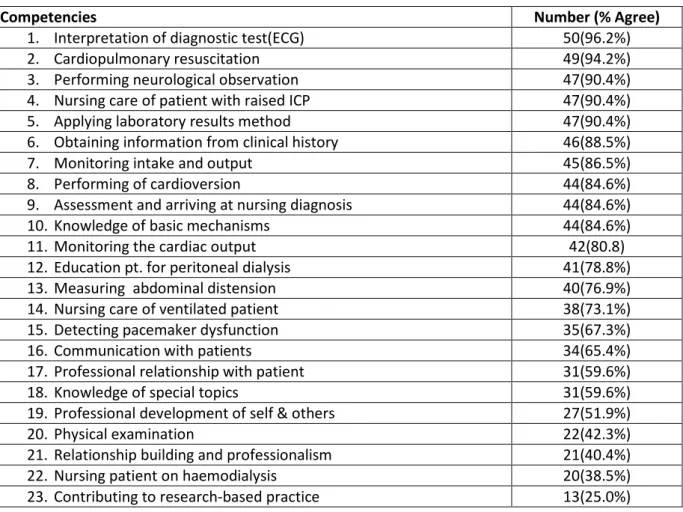
116
- Introduction
- Perceptions of students regarding the use of OSCE as a clinical tool
- Perceptions of the staff regarding the use of OSCE as a clinical tool
- Limitations
Almost half of the students expressed concern about potential bias due to inter-patient and inter-rater variability when using the OSCE. Of the four factors used to measure attitudes and perceptions of using the OSCE to assess clinical skills, the process factor showed the lowest level of agreement. Several studies have shown that the OSCE provides a valid and reliable assessment of applications.
A second concern is the low rating for Professional and Interpersonal Skills with the lowest level of agreement at the “Know” level was in relation to the use of the OSCE for the assessment of research skills which were highlighted as tools for. Analysis of the results revealed that all critical care nurses agreed that the OSCE was a useful exercise to assess the level of knowledge and the level of practical knowledge.
125
Introduction
Recommendations
Thus, feedback must be part of the structure on which an OSCE is based, and the means by which feedback is prepared and presented to students must be thoroughly examined and considered. Secondly, the anxiety factor requires attention, because it is clear that some people have a higher state of anxiety than others. It is therefore important that the faculty take measures to reduce anxiety during exams, for example by giving students sufficient time to practice their skills in a simulated environment before the actual exam.
Finally, to ensure the reliability and validity of the OSCE study, it is important to train the SPs/standardized patients so that they can be consistent in their performance. Boursicot and Roberts (2005) argue that it is necessary to have standardized patients trained across different ages and ethnicities, as well as a balanced gender mix.
Conclusion
128
34;Integrative thinking and learning in undergraduate nursing education: Three strategies." International Journal of Nursing Education Scholarship 5(1): 1-15. 34;The use of simulation in teaching and learning in the health sciences: A systematic review. " Journal of Nursing Education 49(1). 34; OSCE - seven years on the move: Advancing an objective structured clinical assessment program." Nurse Education Today.
34;Standardizing the assessment of clinical competence: an overview of intensive care course design." Critical care nursing. 34;The objective structured clinical examination (OSCE): optimizing its value in nursing education." Nurse today.
